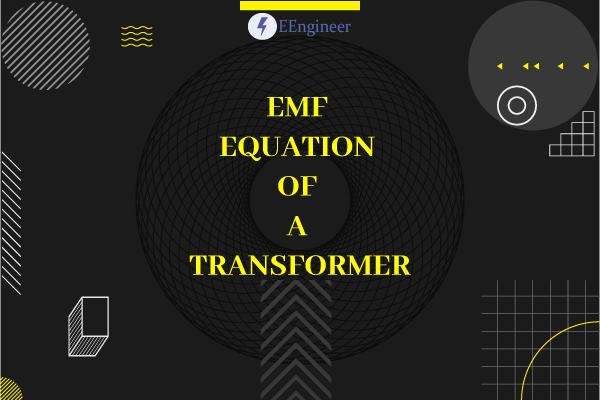A Transformer has a primary side and a secondary side. One is a high voltage(HV) side and the other is a low voltage(LV) side depending upon the application. If someone buys a transformer from the market. He or she doesn’t get to know, which is the HV side and which is the LV side by the naked eye. So we need to know the EMF Equation of a transformer to define the primary and secondary winding.
Table of Contents
Mutual flux inside a Transformer
The mutual flux in the core is proportional to the sinusoidal applied Alternating current source. Also illustrated in the figure, between points ‘a’ and ‘b’, the total change of flux is 2ϕm Webers.
This change of flux occurs in a half cycle, or in a time T/2 sec, where T is the time period, or the time required for the one wave to complete one cycle. The time T/2 and 1/2f seconds are equally related.
What is the EMF Equation of a transformer?
Whenever the primary side of the winding is connected to the source. A current flows in the transformer’s primary side. As you know there is no electrical connection between primary and secondary winding. Hence a medium is needed for the transfer of power. Which is the core of the Transformer. Now, this power travels as the mutual flux transfers. Accordingly, we are going to derive the EMF equation of a transformer.
According to Faraday’s law of electromagnetic induction, Mutual flux induces the EMF in the secondary winding. This mutual flux induces EMF in both, primary and secondary windings. Whereas In primary winding it is known as back EMF, which is very less practical.
Finally, the total EMF induced in each winding must be proportional to the number of turns in that winding.
E_1 \propto N_1
\frac{E_1}{N_1} = \frac{E_2}{N_2}Where both E1 and E2 are the primary and secondary induced EMFs respectively and N1 and N2 are the numbers of turns in the primary and secondary winding.
Derivation of the EMF Equation of the transformer
As in the following figure, mutual flux is sinusoidal. Further, we are going to derive the EMF equation of the transformer.
\phi = \phi_m sin\omega t~---------~(1)
e_1=- N_1 \frac{d\phi}{dt}
~---------~(2)Further, Put equation (1) in (2).
e_1=-N_1\phi_m\omega.cos\omega t
The maximum EMF is at (Cosωt = 1)
E_m=-N_1\phi_m\omega~~~~volts
Put ω = 2πf.
E_m=-2\pi f.N_1\phi_m~~~volts
E_{rms}=-\frac{2\pi}{\sqrt2} f.N_1\phi_m~~~voltE_{rms}=-\sqrt2\pi f.N_1\phi_m~~~voltsOR
E_{rms}=-4.44 f.N_1\phi_m~~~voltsAlso, it(E1 = -4.44 f N1 ϕm) is called the EMF Equation of a transformer. Here negative sign is due to Lenz’s law.
Similarly, secondary-side-induced EMF is calculated by
\frac{E_1}{E_2} = \frac{N_1}{N_2}Further, by Putting a value on the E1, we get
\frac{4.44 f.N_1\phi_m}{E_2} = \frac{N_1}{N_2}N1 cancels both sides.
4.44 f .\phi_m N_2 = E_2
Similarly, this is the formula for the induced EMF Equation of the transformer on the secondary side.
Basically in terms of the maximum flux density Bm (WB/m2) in the area of the cross-section of the core.
E_{rms}=-4.44 f . N B_m A ~ voltsThe applied voltage must balance the induced primary voltage E1 and hence,
V_1=4.44 f . N_1 \phi_m ~ volts
Thus we see that the applied voltage V1 and secondary voltage -E2 are π radians out of the phase.
The ratio of the induced voltage in the two winding is called voltage transformation ratio K. Now this helps to calculate other parameters of the transformer.
K=\frac{E_1}{E_2} = \frac{N_1}{N_2} Especially as per IEEE consideration, a practitioner should take the below formula.
K=\frac{E_{H.V}}{E_{L.V}} = \frac{N_{H.V}}{N_{L.V}} The EMF equation of the Transformer shows, that the EMF per number of turns is the same for the primary as well as the secondary winding.
What is the Turn Ratio?
Turn ratio is defined as the ratio of the number of turns of the primary to the secondary winding. This is a unitless quantity because it is a ratio of the number of turns.
\bf Turns~Ratio= \bf \frac{Number~of ~Primary~turns~(N_1)}{Number~of ~Secondary~turns~(N_2)} Also,~\bf Turns~Ratio= \bf \frac{N_1}{N_2} = \bf \frac{V_1}{V_2} = \bf \frac{I_2}{I_1} What is the Voltage Transformation Ratio?
The Voltage transformation ratio of the transformer is V2/V1. Similarly, this gives the idea of the transformer’s ability to voltage transformation. It is denoted by K.
\bf Voltage~Transformation~Ratio,~K=\frac{V_2}{V_1}Further, For the ideal transformer, the volt-ampere is equal to the output volt-ampere. So it will be as below:
\bf V_1 I_1= V_2 I_2
Therefore Voltage transformation ratio may be written as:
Also,\bf Voltage~Transformation~Ratio,~K=\frac{V_2}{V_1}=\frac{I_1}{I_2}Thanks for reading this Article.
FAQ related to EMF Equation of a Transformer, Turns Ratio, Transformation Ratio
which equation describes the size of the emf in the primary winding of a transformer
The EMF E1 in the transformer’s primary winding is given by E1 = -N1 d/dt(φ), where N1 is turns and d/dt(φ) is flux change over time.
transformation ratio in transformer is
The transformer’s transformation ratio (k) is the quotient of primary turns N1 to secondary turns N2, mathematically expressed as (k =N1/N2).
what is transformation ratio of transformer
Transformer’s transformation ratio (k) is (N1/N2), denoting the relationship between primary (N1) and secondary (N2) winding turns.
what is voltage transformation ratio
The voltage Transformation Ratio (k) in a transformer is (V1/V2), depicting the relationship between primary ((V1)) and secondary ((V2)) voltages.
the transformation ratio in the step up transformer is
Step-up transformer’s transformation ratio (k) > 1, indicating voltage increase is k = N1/N2, with more primary turns (N1).
